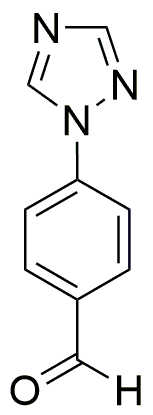4-(1,2,4-Triazol-1-yl)benzaldehyde is widely utilized in research focused on:
- Pharmaceutical Development: This compound serves as a key intermediate in the synthesis of various pharmaceuticals, particularly antifungal agents, enhancing the efficacy of treatments.
- Agricultural Chemistry: It is used in the formulation of agrochemicals, contributing to the development of effective fungicides that protect crops from fungal infections.
- Material Science: The compound is explored for its potential in creating advanced materials, such as polymers with enhanced properties, which can be valuable in various industrial applications.
- Biochemical Research: Researchers utilize this compound in studies related to enzyme inhibition and receptor binding, aiding in the understanding of biological processes and disease mechanisms.
- Analytical Chemistry: It is employed as a reagent in analytical methods, helping to identify and quantify other chemical substances in complex mixtures, thereby improving accuracy in research.
Informations générales
Propriétés
Sécurité et réglementation
Applications
4-(1,2,4-Triazol-1-yl)benzaldehyde is widely utilized in research focused on:
- Pharmaceutical Development: This compound serves as a key intermediate in the synthesis of various pharmaceuticals, particularly antifungal agents, enhancing the efficacy of treatments.
- Agricultural Chemistry: It is used in the formulation of agrochemicals, contributing to the development of effective fungicides that protect crops from fungal infections.
- Material Science: The compound is explored for its potential in creating advanced materials, such as polymers with enhanced properties, which can be valuable in various industrial applications.
- Biochemical Research: Researchers utilize this compound in studies related to enzyme inhibition and receptor binding, aiding in the understanding of biological processes and disease mechanisms.
- Analytical Chemistry: It is employed as a reagent in analytical methods, helping to identify and quantify other chemical substances in complex mixtures, thereby improving accuracy in research.
Documents
Fiches de données de sécurité (FDS)
La FDS fournit des informations de sécurité complètes sur la manipulation, le stockage et l’élimination du produit.
Spécifications du produit (PS)
Le PS fournit une description complète des propriétés du produit, notamment sa composition chimique, son état physique, sa pureté et les exigences de stockage. Il détaille également les plages de qualité acceptables et les applications prévues du produit.
Certificats d'analyse (COA)
Recherchez des certificats d'analyse (COA) en saisissant le numéro de lot du produit. Les numéros de lot et de lot se trouvent sur l'étiquette d'un produit, après les mots « Lot » ou « Lot de fabrication ».
Numéro de catalogue
Numéro de lot/série
Certificats d'origine (COO)
Ce certificat d'exploitation confirme le pays dans lequel le produit a été fabriqué, et détaille également les matériaux et composants utilisés et s'il est issu de sources naturelles, synthétiques ou autres sources spécifiques. Ce certificat peut être requis pour les douanes, le commerce et la conformité réglementaire.
Numéro de catalogue
Numéro de lot/série
Fiches de données de sécurité (FDS)
La FDS fournit des informations de sécurité complètes sur la manipulation, le stockage et l’élimination du produit.
DownloadSpécifications du produit (PS)
Le PS fournit une description complète des propriétés du produit, notamment sa composition chimique, son état physique, sa pureté et les exigences de stockage. Il détaille également les plages de qualité acceptables et les applications prévues du produit.
DownloadCertificats d'analyse (COA)
Recherchez des certificats d'analyse (COA) en saisissant le numéro de lot du produit. Les numéros de lot et de lot se trouvent sur l'étiquette d'un produit, après les mots « Lot » ou « Lot de fabrication ».
Numéro de catalogue
Numéro de lot/série
Certificats d'origine (COO)
Ce certificat d'exploitation confirme le pays dans lequel le produit a été fabriqué, et détaille également les matériaux et composants utilisés et s'il est issu de sources naturelles, synthétiques ou autres sources spécifiques. Ce certificat peut être requis pour les douanes, le commerce et la conformité réglementaire.


